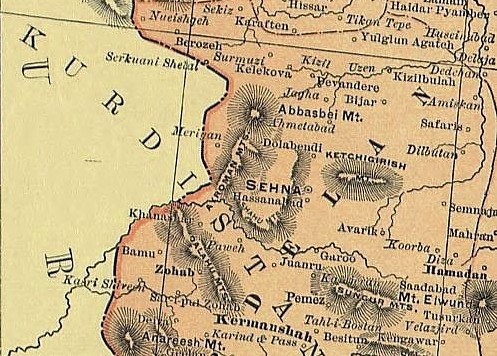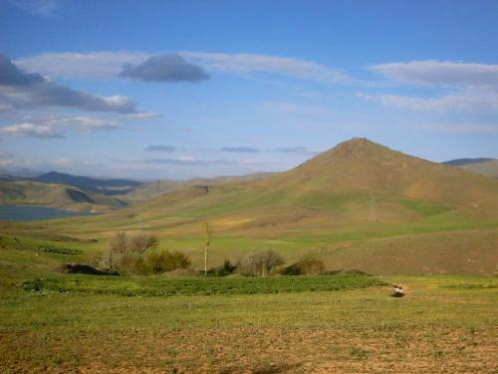| The Heroic and Historic Era The Kurdish Era The Qajar Era The Pahlawi Era |
The Zarrinkafsch-Bahman (Qajar) Family |
Family History
The
House of Zarrinkafsch-Bahman has a splendid and colourful history of more than
2000 years, often connected with the long history of the Land of
Iran. Hence, our family has mythological Avestan roots as well as Parthian and Sasanian blood, while history became legend and legend became myths....
In paternal line we belong to the Zarrinnaal Family from the Kurdish tribe of
Zarrinkafsh, originally seated at Sehna or Senneh (Sanandaj), the capital city of the Persian province of Kurdistan and thus were named Zarrinkafsch. Several tribal chiefs or begs of this clan worked as bureaucratics for the Persian state and over generations the family is connected by blood to the Qajar Dynasty of Persia (r. 1785 to 1925).
In maternal line we belong directly to the Bahman-Qajar princely line, the family of Prince Bahman Mirza Qajar (1810-1884), the famous Wali of Azerbaijan.
In maternal line we belong directly to the Bahman-Qajar princely line, the family of Prince Bahman Mirza Qajar (1810-1884), the famous Wali of Azerbaijan.
We originated from Persia's province Ardalan in Kurdistan with its capital city of Sehna or Senneh which is today's Sanandaj.
To watch a short historical summary about the family's past heads - click here.)
Origin of the Family Name
Unlike
in Europe, where family names were used commonly since the Middle Ages,
in Persia or Iran family names were not known since they were mandated
by Reza Shah Pahlawi in 1930 when his modernization reforms reached all
spheres of social life. Until these reforms,
there was neither need nor tradition to use hereditary family names in
the formal meaning of today. Instead, individuals were distinguished by
characteristic surnames. Only
some distinct tribes bore names their members sometimes were named
after, like e.g. the "Afshar", "Zand" or "Qajar" lines and finally the
"Zarrinkafsh" tribe, too. Mainly commoners as well as noble men were named either to their
original homeplace, village, town or province, like e.g. "Shirazi",
"Esfahani", "Tabrizi", or "Kordestani" (meaning those, who came from
Kurdistan, etc.), or
to an alledged ancestor such as "Bahman" (-> Bahman Mirza), to a job
or office such as "Monshi" (i.e. secretary), "Lashkar-newis" (i.e. army
scribe) and "Wali" (i.e. vicegerent), or to honorific titles (laqab)
such as "Moayyer ol-Mamalek" (lit. "Assayer of the Realm"), "Nasr-e
Lashkar" (lit. "Defender of the Army"), "Zia os-Soltan" (lit.
"Splendour of the Sovereign"), etc.
Often
men of public life only were known by their special titles, and when it
came usually in 1930 to choose a name, many of those families, who had
one or several titled members, chose a family name, that was taken from
the first part of their former laqab, such as for example the title "Moayyer ol-Mamalek" became the family name of "Moayyeri", "Sana ol-Molk" became "Sana'i", etc.
About the history and origin of our own family and surname Mr Borhan Ayazi states in his historical book about the city of Sanandaj A’ineh’-ye Sanandaj (“Mirror of Sanandaj”), 1360, p. 31, chapter ‘Emarat-e Khusrowabad (“The Residence of Khusrowabad”):
“…before
the year of 1632 Senneh was a little settlement. In this little
settlement the tribe of Zarrinkafsh had a respected life. And the
historians told us about the family of Zarrinkafsh: The tribe of
Zarrinkafsh, which is called in Kurdish dialect Kosh-e Zarrin,
has an ancestry line going back to Tus-Nowzar, a famous hero in the
Shahnameh. This very same tribe of Zarrinkafsh were the original
inhabitants of Senneh (Sanandaj) before the clan of the Ardalans. The
peak of the lower part of town, resting between town and the Qeshlaq river, this peak had been Tus-Nowzar’s camp, because there
his tent was made and wine was served. And this is the reason why this
peak became popular as ‘Peak of Tus-Nowzar’. There you have a nice view
there, and from East and West, North and South it is a beautiful
panorama. Regardless of which side one enters the city of Sanandaj,
this peak is always visible. Thus, the members of the tribe of Zarrinkafsh,
who were the first settlers in Senneh, wore the ‘klut’ (a distinct headgear) and the ‘shala'i’
(a black shawl around the headgear), which was wrapped around the
headgear in a specific way. And they wore shoes stitched with golden
silk on their feet, which had been the attribute for royal ancestry.
And this was the reason why that tribe was called Zarrin Kafsh i. e.
“Golden Shoe”. Some of these people descending from the tribe of
Zarrinkafsh and the House of Nowzar still resided in Sanandaj until now
and live a respected and honoured life."²
Other authors mentiond this story as well, like Mrs Sheerin Ardalan in her book
Les Kurdes Ardalân, Paris 2004, on page 40:
"Le
nouveau vâli [Soleyman Khan Ardalan] choisit l'ancien bourg de
Sena/Sanandaj, fief de la vieille tribu des Kafsh-e Zarrin ("bottines
d'or") situé à un farsang de Hasanâbâd, comme capitale. ..." And in footnote 112 at that page she also wrote: "Cette
très anciennes tribu remonte à Tus, fils de Nowzar, héros et sepahdâr
(chef de l'armée), aux bottines d'or, du roi mythique Key Khosrow.
Jusqu'à la première moitié de notre siècle, les hommes et femmes de
cette tribu continuèrent à porter des chaussures en cannetille d'or
(golâbtun), symbole de la royauté dans l'ancienne Perse. Une colline à
l'est de Sena [Sanandaj] porte encore aujourd'hui le nom de Tus-e
Nowzar, en souvenir des agapes que celui-ci organisait à cet endroit."
Kurdistan, landscape of Sanandaj, the original homeplace of our family.
To continue to The Heroic and Historic Era - click here
----------------------------------------
² "...qabl
az sal-e 1042 Senneh qariyeh-ye kuchaki budeh ke tayefeh-ye Zarrin
Kafsh dar in qariyeh-ye kuchak zendegi-ye abrumandaneh dashtehand wa
mowarrekhin darbareh-ye khanewadeh-ye Zarrin Kafsh chenin neweshtehand
tayefeh-ye Zarrin Kafsh ke be lahje-ye kordi (Kosh-e Zarrin) miguyand
nasab-e ishan be Tus-Nowzar pahlawan-e mashhur dar shahnameh montahi
mishawad, sakaneh-ye asli-ye Senneh (Sanandaj) qabl az tayefeh-ye
Ardalan-ha hamin tayefeh-ye Zarrin Kafsh-ha budehand, tappeh-ye
pa’in-shahr ke hayel beyn shahr wa rudkhaneh-ye qeshlaq ast […] in
tappeh [be] piyaleh-gah-e Tus-Nowzar ma‘ruf budeh ke dar anja baraye u
chador zadehand wa badeh peyma’i [mi-]kardeh wa lajeram in tappeh be
tappeh-ye Tus-Nowzar ma‘ruf shodeh ast ke az nazar-e tamasha-gah az
sharq wa gharb wa shomal wa jonub ja-ye besiyar ‘ali wa jaleb ast,
betouri ke har kas az har taraf wared-e shahr-e Sanandaj beshawad
mitawanad in tappeh ra molahezeh konad, bari tayefeh-ye Zarrin Kafsh ke
nakhost dar in qariyeh-ye Senneh zendegi mikardehand dara-ye klut
(kolah) wa shala’i (parcheh-ye siyah dour kolah) ke betarz-e makhsus
dour kolah pichidehand budeh wa kafsh-e golabatun-duzi be pa kardehand
ke ‘alamat-e shahzadegi budeh wa be in monasebat an tayefeh ra “Zarrin
Kafsh” goftehand, chand nafari az owlad-ha-ye tayefeh-ye Zarrin Kafsh
wa Nowzari ham aknun dar Sanandaj baqimaneh wa zendegi mohtarmaneh
minamayand."
* * * * *
Ancestry line:
Mohammad Ali Beyg Zarrinnaal > Mohammad Zaman Beyg > Mahmoud Beyg Soltan > Mohammad Beyg > Hajji Eskandar Beyg-e Afghan > Abbas Beyg > Oghli Beyg I > Ali Beyg "Monshi-bashi" > Oghli Beyg II "Monshi" > Agha Mirza Zaman Khan Kordestani "Lashkar-newis" > Agha Mirza Ali Akbar Khan-e Zarrinnaal "Lashkar-newis "Nasr-e Lashkar" > Kazem Khan Zarrinkafsch > The House of Zarrinkafsch (Bahman-Qajar)
Sources:
Shireen Ardalan: Les Kurdes Ardalân, Paris: Geuthner, 2004, p. 40.
Burhan Ayazi: Aineh-ye Sanandaj, Tehran 1980, p. 31.
Ferydoun Barjesteh: "The Fath Ali Shah Project" in: Qajar Studies. Journal of the IQSA, Vol IV, Rotterdam: Barjesteh van Waalwijk van Doorn, 2004, p. 175.
Martin M. van Bruinessen: Agha, Scheich und Staat, Berlin: Edition Parabolis, 1989, p. 92 ff.
Abdollah Mostofi: The Administrative and Social History of the Qajar Period, vol 1, Costa Mesa: Mazda Publishers, 1997, p. 42 ff.
M. Taqi Sepehr Lesan ol-Molk: Nasekh at-tawarikh, edit. I (3), Tehran n. d., p. 439.
Peter Wilcox: Rome's Enemies (3): Parthians & Sassanid Persians, Oxford - New York, Osprey, 1986, pp. 23-28.
Ehsan Yarshater: "Iranian National History", in: Cambridge History of Iran, Vol 3 (2), Cambridge: Cambridge University Press, 1989, p. 460 f.
Arian K. Zarrinkafsch: "Iranian Heraldry", in: Qajar Studies. Journal of the IQSA, Vol III, Rotterdam: Barjesteh van Waalwijk van Doorn, 2003, p. 9-31 (p. 27).
Arian K. Zarrinkafsch: "Transition of Tribal Nobility into Qajar Urban Elite", in: Qajar Studies. Journal of the IQSA, Vol VIII, Rotterdam: Barjesteh van Waalwijk van Doorn, 2008, p. 97-125.
Jafar Zarrinnaal: Surat-e asāmi-ye ağād-e pedari-ye Zarrinna‘al, Tehran 1967, no. 1-12.
Interview with Mr Keywan Zarrinkafsch and Mrs Zarrin-Homa Zarrinnaal, 1995, Mr Ahmad Zarrinnaal, 2003, and Mrs Victoria Zarrinkafsh, 2005.
This website was created by Arian K. Zarrinkafsch (Bahman-Qajar).



